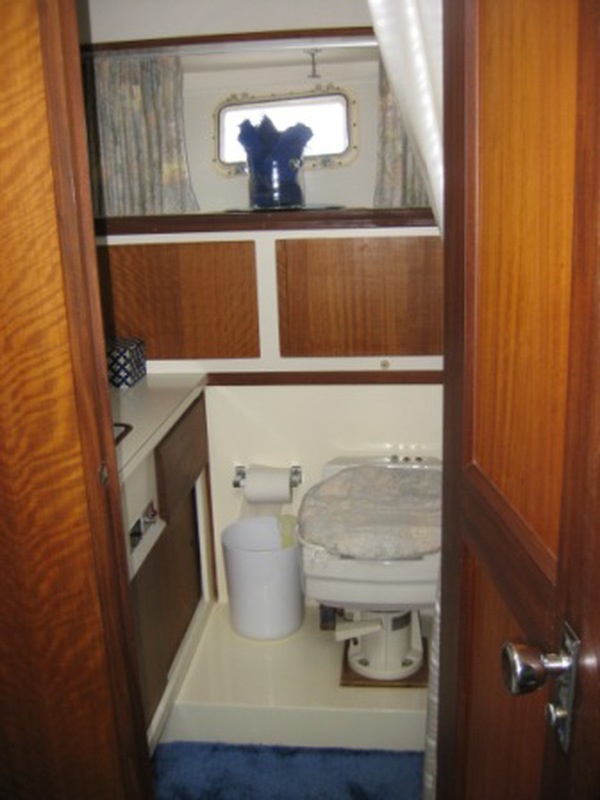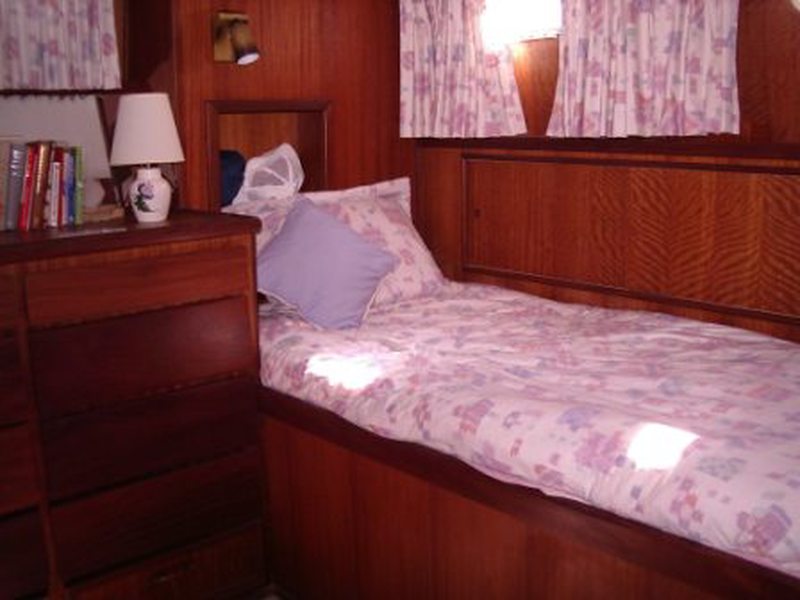
38' 1973 Hatteras Motor Yacht ***SOLD***
| Type: | Powerboat | Year: | 1973 | Make: | Hatteras Motor Yacht |
|---|---|
| Model: | ***SOLD*** |
| Length: | 38' |
| Status: | Sold | Price: | $ 44,995 | Location: |
|---|---|
| Date Posted: | 2015-04-22 |












Two owner (current since 1982) freshwater yacht is a true classic. Two cabin layout. Generator, air conditioning, stored under cover indoors. 2005 Survey available.
Specifications:
LOA: 38′ 4″
Beam: 13′ 7″
Draft: 3′ 5″
Engines: Twin Chris Craft 427, 300hp ea. 1400hrs. Closed cooling
Tankage:
Fuel 2x150g
Water 145g
Waste Yes
Electronics:
VHF Radio
Depth
Autohelm 5000 Autopilot
Knotmeter
Mechanical and Accessories:
7.5kw Kohler gas generator
Air conditioning
Flybridge bimini
Review by Jack Hornor, NA
The headquarters of Hatteras Yachts is located in High Point, NC, 270 miles inland, as the crow flies, from the cape of the same name that is reputed for it’s treacherous seas and numerous wrecked ships. I am sure it was by no means coincidental that Hatteras’ founder, Willis Slane, chose this name for his new company. For a time, Hatteras used the slogan “Proven in the graveyard of the Atlantic†and pointed out in their advertising that every Hatteras hull design was tested in the treacherous waters of Cape Hatteras.
In the nearly 40 years since its founding, Hatteras Yachts has not only built a reputation for building yachts capable of withstanding punishing seas but, in the recreational marine business, the name Hatteras has become synonymous with high quality fiberglass motor yachts and sports fisherman.
The Hatteras 38 double-cabin motor yacht (DCMY) was designed, as were nearly all Hatteras Yachts, by Jack Hargrave who had a simple, straightforward approach to yacht design. Hargrave believed that good function was good design and that every boat should look good without a lot of decoration or trim.
The first Hatteras 38 DCMY was introduced in 1968 and a restyled version introduced in 1973. Our focus will be on the restyled version in production from 1973 through 1978.
By today’s standards, the appearance of the 38 would likely be considered a bit stubby but in 1973 this was a very stylish yacht. In profile the design is very well balanced with a raised deck over the aft cabin, a centered main saloon, and uncluttered forward deck. The flybridge is positioned atop the main saloon and puts the helmsman right in the center of the action. There was an optional lower helm offered along the starboard side of the main saloon. Side decks along each side of the saloon are a bit narrow but adequate to allow movement fore and aft without risking life and limb.
The hull is a modified V, hard chine, planing form. The forward sections of the hull are quite V-shaped for easy entry and reduced pounding in choppy seas, giving way to less V-shape sections aft. This provides for more lift with out excessive horsepower. There is an integral keel that adds to strength of the hull as well as improving tracking, particularly at slower speeds.
All Hatteras Yachts are constructed of fiberglass, or more accurately, fiberglass reinforced plastic (FRP). The hulls are laid up as a single piece in a female mold using various types of fiberglass cloth set in polyester resin. Longitudinal stringers are foam core molded FRP capped with metal plates where the engines are installed. The stringers are set in place before the final layer of fiberglass is laid-up which adds to the strength and reduces the chances of secondary bonding failures at the attachments. Full and partial plywood bulkheads are bonded to the hull with fiberglass cloth and polyester resin. The deck and hull are fastened together with adhesives and mechanical fasteners. The engineering of and the materials used for construction are all first rate; quality control is high which result in a very strong boat with no known problems aside from the normal wear and tear of age and service.
Although not unique to Hatteras, one somewhat unusual feature of their construction is fuel tanks, water tanks and waste holding tanks of FRP construction. This eliminates the potential for corrosion and leaking welded and soldered joints associated with metal tanks and results in stronger more durable tanks than molded plastic.
No doubt a more modern design would attempt to cram at least two queen size berths and two heads with separate showers into a boat of this length and beam, but I think it’s very hard to find fault with the very practical accommodations offered by this layout.
The master stateroom is aft fitted with twin berths outboard on each side of the cabin. There are opening ports above each berth and on the transom for ventilation. There is a large dresser along the transom between the berths an adequate size hanging locker and separate linen locker. There is a private head for the master stateroom with separate stall shower.
The main saloon is amidships over the engine room and features a sofa along the starboard aft bulkhead the converts to make a fore and aft berth. Most boats were also fitted with two small chairs and a small drop-leaf table. Large windows on both sides and forward make for a very open, airy feeling. Sliding windows on each side provide for good cross ventilation.
Down and to the starboard side is the galley area that features a 14 cu. ft. standup refrigerator-freezer, three burner electric range, oven and small single stainless steel sink.
Opposite the galley is the forward head with vanity, sink and integral shower. Forward of the head is a large hanging locker and further forward is the v-berth forward cabin with plenty of storage below the berths.
Hatteras has always taken a great deal of pride in the quality of their cabinet and joiner work. The interior features a considerable amount of hardwood and veneered plywood all very well finished for a very yacht-like look.
(Note: The 1968-72 38 DCMY had a considerably different deck layout and accommodation with the galley on the same level as the main saloon with v-berth, head and small stateroom forward.)
The standard engine installations on Hatteras 38 DCMYs of this vintage was either twin 283Hp, 6-cylinder, fresh water cooled General Motors diesel engines or 300Hp, fresh water-cooled gasoline engines. All 38 DCMYs were equipped with auxiliary generators, either gasoline or diesel, depending on the engine installation.
A reasonable cruising speed of about 15 knots can be expected with a top speed of 18 to 20 knots depending on wind and weather and how the boat is loaded.
There is not a great amount of flare in the bow and the foredeck can get a little wet in short, choppy seas but the combination of hull shape and moderate speeds virtually eliminates pounding in all but the worst conditions. In a quartering or following sea there is little tendency to yaw. The 38 DCMY is as well mannered as any vessel of this size and class and better than most.
On the plus side there are a number of things that come to mind. Some are obvious and I have already mentioned them such as solid construction and excellent maneuvering, particularly in quartering and following seas. Some that are not so obvious include conveniently placed hand rails, deck rails that are high to keep you aboard rather than trip you overboard and electrical installations that are neatly installed and labeled so that one can determine what goes where.
No boat is without its negatives if for no other reason than every boat is a compromise. As I mentioned earlier, some 38s were fitted with a lower helm although visibility astern is very limited and communications with deck hands is nearly impossible from the lower helm. My clear preference would be to sacrifice the lower helm and enclose the flybridge for protection in inclement weather. This is by no means an inexpensive solution because a complete enclosure of bridge will likely cost in excess of $5,000.
By today’s standards, the 38 is a bit slow. Another common complaint of the 38 is that there is no double berth in either stateroom. This can be remedied for a few hundred dollars by adding a filler cushion for the forward V-berth cabin. This results in a very large berth but considerably restricts the space in the cabin area.
In creased maintenance cost of older boats is always a legitimate concern. The Hatteras 38 has no particular idiosyncrasies that make it any more prone to problems than other boats. The two major cost of maintaining older boats is refinishing when necessary and repowering or rebuilding engines. Refinishing costs will vary greatly depending on the condition of the finish and the extent of the job to be done. To simply paint the hull cost between $4,000 to $5,000 while a complete refinish of an older boat could exceed $25,000. Engine rebuilds on gasoline engines will likely cost between $2,500 and $5,000 each depending on the needs and diesel rebuilds will likely run from $6,000 to $12,000 each, again depending on the condition of the engine and what needs to be done.
There are usually several Hatteras 38 DCMYs on the market at any given time. Keep in mind that those older than 1973 have a different deck plan and cabin layout than what we have discussed here. The published used book prices for 1973 to 1978 models range from $70,000 for a 1973 gas model to $100,000 for a 1978 diesel model. My experience tells me these prices are likely understated in the present market. In my research for this article, I was able to locate three boats offered for sale from Connecticut to Florida. The asking (not necessarily selling) price for all averaged nearly 30% over the published book prices.
I have never known a Hatteras owner that did not take a great deal of pride in his or her yacht. Their reputation for quality and durability is well deserved, although $100,000 plus for a 38-foot, 25-year-old boat is a little steep. The open deck spaces and good-sized main saloon make the 38 DCMY ideal for cruising with from four to six people and comfortably entertaining for 10 or more. If the 38 fits into your budget and boating needs, its a tough boat to beat.





